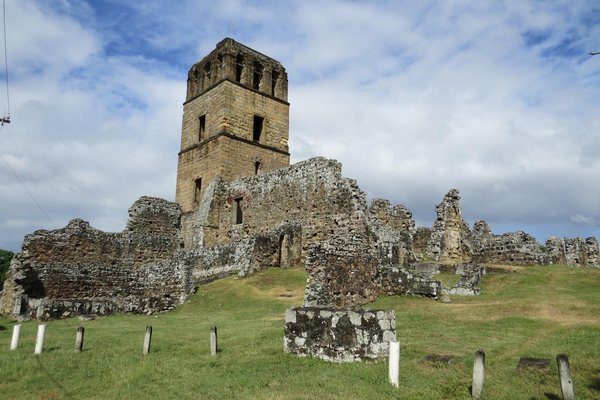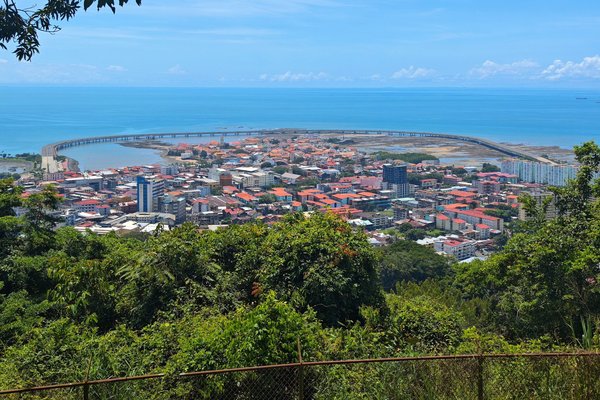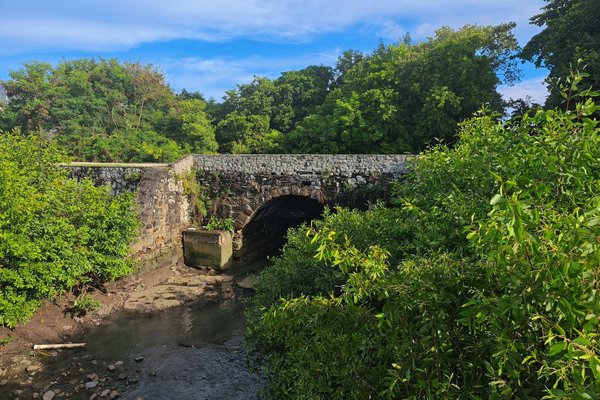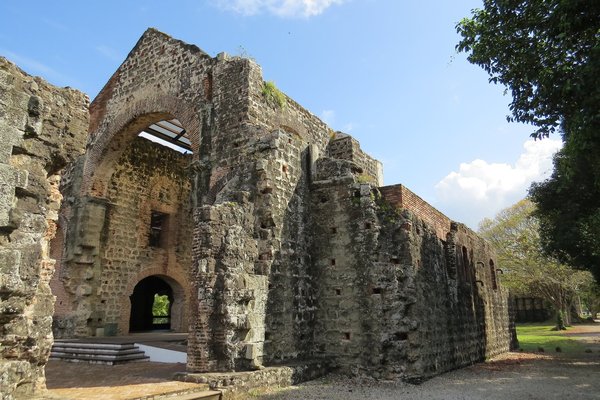Panama
The Colonial Transisthmian Route of Panamá
The Colonial Transisthmian Route of Panamá comprises 6 sites that represent the efforts of the 16th-century Kingdom of Spain to enable a global transportation system with its colonies via the isthmus.
It includes the Archaeological Site of Panamá Viejo and Historic District of Panamá, the Castle of San Lorenzo (a defense system to protect the port and roads), and three sections of Camino de Cruces. Its roads were used until the mid-18th century, after which the importance of the route declined due to the increasing use of the Cape Horn route. The route also facilitated a mutual sharing of beliefs, crafts, and heritage among various communities.
A second phase for this serial site, adding Portobelo and a section of the Camino Real, is planned.
Community Perspective: The first two sites lie about 11km from each other in different parts of Panama City. Solivagant has described Casco Viejo’s bad state of conservation in 2012, while Els in 2015 mentions improvements but also new threats. Overall, most reviewers find the Site of Panamá Viejo the most satisfying of the two to visit, though Ilya found Casco Viejo “pleasing to the eye”. Dwight was the first to explore the Camino de Cruces.
Site Info
Official Information
- Full Name
- The Colonial Transisthmian Route of Panamá (ID: 1582)
- Country
- Panama
- Status
-
Inscribed 2025
Site history
History of The Colonial Transisthmian Route of Panamá
- 2025: Revision
- The Archaeological Site of Panamá Viejo and Historic District of Panamá, which was previously inscribed on the World Heritage List, is now part of The Colonial Transisthmian Route of Panamá.
- 2024: Referred
- .
- 2023: Incomplete - not examined
- .
- 2003: Extended
- To include the Archaeological Site of Panamá Viejo
- 2003: Name change
- From "Historic District of Panamá, with the Salon Bolivar" to "Archaeological Site of Panamá Viejo and the Historic District of Panamá"
- 1997: Inscribed
- Inscribed
- 1996: Deferred
- Panama Viejo; Bureau - more info on plans and revitalisation of the area
- Type
- Cultural
- Criteria
- ii
- iv
- vi
Links
- UNESCO
- whc.unesco.org
- Official
-
- tourismpanama.com — Casco Viejo
- panamaviejo.org — Panama Viejo
All Links
UNESCO.org
- whc.unesco.org — whc.unesco.org/
Official Website
- tourismpanama.com — Casco Viejo
- panamaviejo.org — Panama Viejo
News Article
- Oct. 28, 2012 archrecord.construction.com — Panama City Highway Stirs Controversy
- June 6, 2011 newsroompanama.com — A devastating Unesco report on Panama's Casco Viejo, warns that if the third stage of the Cinta Costera goes ahead, under or around the old city, it will almost certainly lose its valuable World Heritage listing
- Feb. 17, 2010 nuwireinvestor.com — Panama City Of Casco Viejo Undergoing Massive Infrastructure Improvement
Community Information
- Community Category
- Urban landscape: Colonial
Travel Information
Recent Connections
-
Mentioned in Paradise Lost
"And Panaman on the Isthmus." Published…
-
Phased inscriptions
Two phases foreseen, of which one is st…
-
Pan-American Highway
Connections of The Colonial Transisthmian Route of Panamá
- Individual People
-
-
Francisco Pizarro
Mayor
-
- Geography
-
-
Located in a Capital City
Panama City (Capital of Panama) -
Pan-American Highway
-
Pacific Ocean
-
- Trivia
-
-
Built or owned by French
Museo del Canal Interoceánico de Panamá is located in a building once owned by the French canal company "Compagnie Universelle du Canal Interocéanique"; French Embassy at the Plaza de Francia -
Moved from location of original construction
Iglesia de la Merced -
On Banknotes
The Cathedral of Panama Viejo, shown on the former 10 Balboas banknote (Panama uses the US dollar now) -
Built or owned by Spanish
Panama Viejo: A settlement was founded on 15 August 1519 by Pedro Arias D'Avila and other 100 inhabitants. At the time, it was the first permanent European settlement on the Pacific Ocean, replacing the two cities of Santa María la Antigua del Darién and Acla. (wiki)
-
- History
-
-
Congresses and Conferences
Salon Bolivar - "Panama Congress" (1826) - organised by Bolivar in an attempt to promote pan-American unity -
Camino Real
"Durante su historia desde el siglo XVI hasta el siglo XIX, el Camino Real fue, junto con el Camino de Cruces, una de las dos únicas rutas para cruzar el Istmo de Panamá. El camino, creado poco despues del descubrimiento del Mar del Sur, conectaba la ciudad de Panamá Viejo primero con Nombre de Dios y despues de 1597 con Portobelo" -
Declarations of Independence
In the center of Casco Viejo is the Plaza de la Independencia, where Panama declared its independence from Colombia in 1903
-
- Architecture
-
-
Art Deco
Building at Plaza de la Independencia (Casco Viejo) -
Coral Masonry
-
- Damaged
-
-
Destroyed or damaged by Earthquake
Panamá Viejo was ravaged by the earthquake of 1621 and suffered important damages (even partial collapses) in a very strong earthquake on September 7, 1882.See es.wikipedia.org
-
- World Heritage Process
-
-
Reformulations
Replaced and extended the WHS of Panama Viejo and Casco Viejo
-
First inscriptions
Panama 1980 -
Single Monuments
The "Salon Bolivar" was inscribed as a single Monument, together with Panama Viejo (site) and Casco Viejo (group of buildings) -
Phased inscriptions
Two phases foreseen, of which one is still to come.
-
Sites for which a reduction is or was planned
The current WHS of Panamá is part of a renomination effort (The Colonial Transisthmian Route of Panamá), it is expected that not all of the current site will be included. -
Extended
2003: To include the Archaeological Site of Panamá Viejo
-
- Religion and Belief
-
-
Jesuit Order
Remains of a Jesuit Church at Panama Viejo -
Conceptionists
Church and convent at Panama Viejo -
Dominican Order
Remains of a Dominican Church at Panama Viejo -
Cathedrals
"impressive ruins of the cathedral" (Panama Viejo, AB ev) -
Mercedarians
"Continuing two blocks west along Av Cincuentenario, you'll arrive at the ruins of the Iglesia y Convento de La Merced. Erected by the Mercedarian friars in the early 17th century, the buildings actually survived the fire that swept the city following Morgan's assault. However, the church's facade is missing because the friars dismantled it and moved it to Casco Viejo, where it can be seen today."
-
- Human Activity
-
-
Piracy
Henry Morgan 1670, Buccaneers 1671
-
- Constructions
-
-
Cisterns
"Ajibe" reservoir at Panama Viejo -
Purpose Built Visitor Centre
Panama Viejo Visitor Centre. Architect - not known. See link. This states the inauguration date to be 2004, but a 2009 Mission recommended "Relocation of the projected visitor's facility at a considerable distance from the Main Square and the Cathedral Tower to preserve the visual integrity of the site and its setting;". The 2013 report states "The mission visited the new visitor facilities and museum located at the main entrance of Panama Viejo. Located in two buildings, new facilities include administrative area of the Patronato Panamá Viejo, laboratories and exhibition areas that facilitate interpretation of the site by visitors. The mission considers that the 2009 recommendation is fully implemented" -
Bandstand
On Plaza de la Independencia in Casco Viejo -
Theatres and Opera Houses
Teatro Nacional -
Protective Shelters
Salon Bolivar: The little museum is entirely enclosed by glass to protect it and is actually in the courtyard of another building, the massive Palacio Bolívar -
Moats
Casco Viejo: "Most of the seaward walls of the colonial fortifications and parts of the landward bastions and moat survive" (OUV)
-
- Timeline
-
-
Built in the 16th century
first European settlement on the Pacific coast of the Americas, in 1519
-
- Literature & Film
-
-
Mentioned in Paradise Lost
"And Panaman on the Isthmus." Published in 1667, Milton’s snapshot captured the peak of this global transport network just four years before the original city was destroyed by the pirate Henry Morgan in 1671. The site preserves the ruins and trails Milton envisioned. The Sack of Old Panama
-
News
- archrecord.construction.com 10/28/2012
- Panama City Highway Stirs Controve…
- newsroompanama.com 06/06/2011
- A devastating Unesco report on Pa…
- nuwireinvestor.com 02/17/2010
- Panama City Of Casco Viejo Undergo…
Recent Visitors
Visitors of The Colonial Transisthmian Route of Panamá
- Adrian Turtschi
- akacesfan
- Alberto Rodriguez Gutierrez
- Alejandro Lau
- Alex Baranda
- alicemears
- Ali Zingstra
- A. Mehmet Haksever
- Ammon Watkins
- Ana
- Ana Lozano
- AndreaTLV
- Angela Vandyck
- Anne
- Artur Anuszewski
- Atila Ege
- basementonline
- BaziFettehenne
- Bill Maurmann
- Bram de Bruin
- Carlo Medina
- Carlos Sotelo
- chenboada
- Cheryl
- chiuliqi
- Christoph
- Christravelblog
- Cirene Moraes
- Claire Bradshaw
- Clyde
- ctravel
- CynthiaSam
- czesioszpachelka
- dave wood
- David Aaronson
- del
- Delphine Delaunay
- Dennis Nicklaus
- Digits
- Dorejd
- Dwight Zehuan Xiao
- Els Slots
- Erfe91
- Erik Jelinek
- Eva Kisgyorgy
- Fan Yibo
- Feldhase
- Filip Murlak
- Frédéric M
- Frederik Dawson
- George Gdanski
- GeorgeIng61
- Gernot
- Gilles
- giloudepuertorico
- Gjert
- Grzegorz Andruszkiewicz
- Hammeel
- HaraldOest
- Harald T.
- Harry Mitsidis
- H Beswick
- Hdhuntphotography
- Iain Jackson
- Ilya Burlak
- irosey
- Janos
- Jarek Pokrzywnicki
- Jarrod_Byham
- Jason Boulette
- Javier Coro
- Jawnbeary
- Jean Lecaillon
- Jeanne OGrady
- jess4sythe
- João Aender
- Joel on the Road
- Jon Opol
- Justin
- jxrocky
- Karito Vies
- Kasper
- KeithBailey
- kelseyyurek
- kiank37
- Kjlauer
- Krijn
- Kurt Lauer
- Lars Bogstad
- lichia
- Lillybett
- Linz
- Loic Pedras
- Ludvan
- Luis Filipe Gaspar
- lynnz317@aol.com
- Maciej Gil
- Mahuhe
- manuel011197
- Marcobrey
- Matthewrw
- Matthewsharris
- Michael Ayers
- Michael Novins
- michaelsballard
- Mikko
- MMM
- MoPython
- Morodhi
- Mtlmr
- nan
- Nihal Ege
- palka25
- Patrik
- Pchxiao
- petar
- Philipp Leu
- Philipp Peterer
- phillipmeng
- Pieter Dijkshoorn
- Pink Bunny
- Piotr Wasil
- Pradip Tripathy
- pressdm
- Priyaranjan Mohapatra
- Reiseblitz
- Reisedachs
- Reza
- rivr
- Roger Ourset
- Roman Bruehwiler
- Rosemary
- RYU
- sakohju
- Sandra!
- Santiago Lafuente
- Sclowitz
- Sergio Arjona
- Shandos Cleaver
- Shannon O'Donnell
- Slavi
- sncjob
- Solivagant
- Stan
- Szabo Viktoria
- Thomas Buechler
- Timothy C Easton
- TimPick
- Truls Brekke
- ValiaVeweth
- VMThumper
- Westwards
- Wo_ko
- Yi Han Goh
- Yongcheng Liu
- Zizmondka
- zman5455
- Zoë Sheng
Community Reviews
Show full reviewsDwight Zehuan Xiao
Hiking the Camino de Cruces - or so I hoped
The Colonial Transisthmian Route of Panamá (Inscribed)
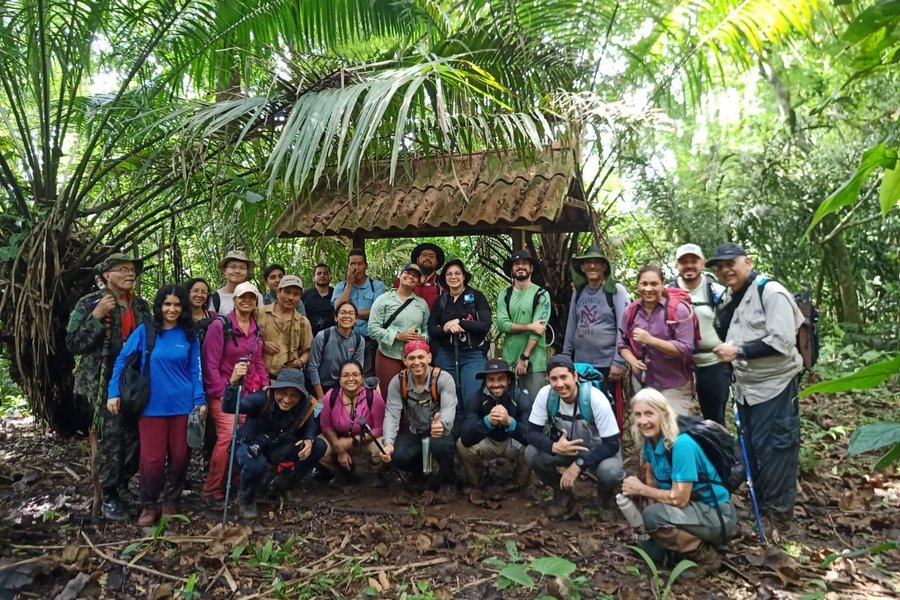
Ever since I learned that I’d be dispatched on a month-long business trip to Panama, I’ve been trying to figure out how to get a real taste of the Camino de Cruces.
The Colonial Transisthmian Route of Panamá was the most puzzling new inscription from the 2025 WHC. I couldn’t understand why it was designated as a replacement for the former Panama City site rather than as its own separate entry. It was only after reading some research papers that I realized this was a tactful move to prevent Panama City from being completely delisted. The threat comes from large-scale urban development projects, most notably Cinta Costera 3 which encircles the whole Casco Viejo, cuts it off from its surrounding seascape, and undermines both its integrity and OUV.
The new nomination of the colonial transisthmian route effectively rewrote the OUV of Archaeological Site of Panamá Viejo and Historic District of Panamá, repositioning the 2 major components rather as terminal stations of an overland crossing than as harbors on the Pacific front. This narrative shift intentionally dissociated the sites from their maritime setting, and thus downplayed the negative impacts of the coastal construction projects that definitively altered the shoreline. In fact, the concerns of WHC were never addressed at all, only evaded.
Nevertheless, the inclusion of 3 sections of the Camino de Cruces illustrates another layer of the strategic importance of Panamá Viejo and Casco Viejo, and clarifies how goods and wealth once flowed between both sides of the isthmus. …
Keep reading 2 commentsIlya Burlak
The Colonial Transisthmian Route of Panamá
The Colonial Transisthmian Route of Panamá (Inscribed)
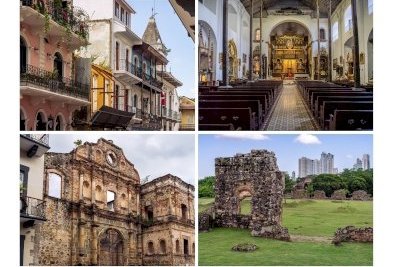
I visited both components of the site in December 2022 while on a layover in Panama City. I will agree with the previous reviewers that Casco Viejo (or Casco Antiguo - both names apparently can be used) is not exactly exceptional in the absolute sense, and probably lacking in OUV, but being a visual person, I liked it more than I liked the Panama Viejo archaeological component. On the negative side, some streets remain clogged with cars and a non-trivial percentage of buildings is in a less-than-perfect state. On the positive side, fine details abound, and the overall ensemble of architectural styles is pleasing to the eye. That is in no small part due to the various balconies that adorn upper floors - Casco Viejo is sometimes rightly called "the city of a thousand balconies".
And the occasional juxtaposition of ruins or otherwise abandoned buildings with well-maintained colonial houses actually adds a measure of interest. You can see that at Iglesia de la Compañía de Jesús, at Arco Chato, and throughout the neighborhood.
As befits a predominantly-Catholic country, churches are the most impressive sights. La Merced, with its timber roof, thin support columns, and exuberance chapels is one. Saint Joseph is home to the incredible Baroque Golden Altar and no less incredible Nativity Scene in its treasury, the most elaborate I've ever seen. The Metropolitan Cathedral is as close to an architectural standout as anything else, with its gleaming-white towers flanking the weathered-stone faςade; its colorful marble altar …
Keep reading 0 commentsAmmon Watkins
The Colonial Transisthmian Route of Panamá
The Colonial Transisthmian Route of Panamá (Inscribed)
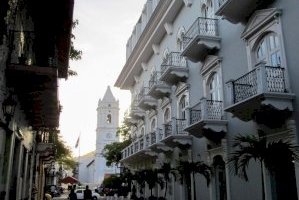
Of the 2 parts of this WHS I enjoyed the ruins of Panama Viejo more than the neighbourhood of Casco Viejo. We easily covered both sites in a day. The ruins are well preserved in a state of (mostly) unrestored rubble but it is not hard to get a feel for the layout of the settlement and there is a very good museum on site to help get the most out of it. As the original settlement of Panama and the first by the Spaniards on the Pacific coast, a visit here was essential to our overall appreciation and understanding of the colonization of the new world, a theme we'd been following quite closely for the last couple years in our travels.
Casco Viejo is just another small colonial core much like any other in Latin America and unique only in its later French influences. Restoration work is still ongoing but there are still many empty buildings shells between restored sections. This adds a degree of character to the area and I wonder if this is in part by design. I'd like to see the overall plan to see what the final goal for the restoration work is. If they even know! If anything the tourist dollar should keep them motivated to keep working at it. There is still a very visible police presence in the area but all the uber drivers I asked confidently replied that security concerns were a thing of the past, just don't go wandering …
Keep reading 0 comments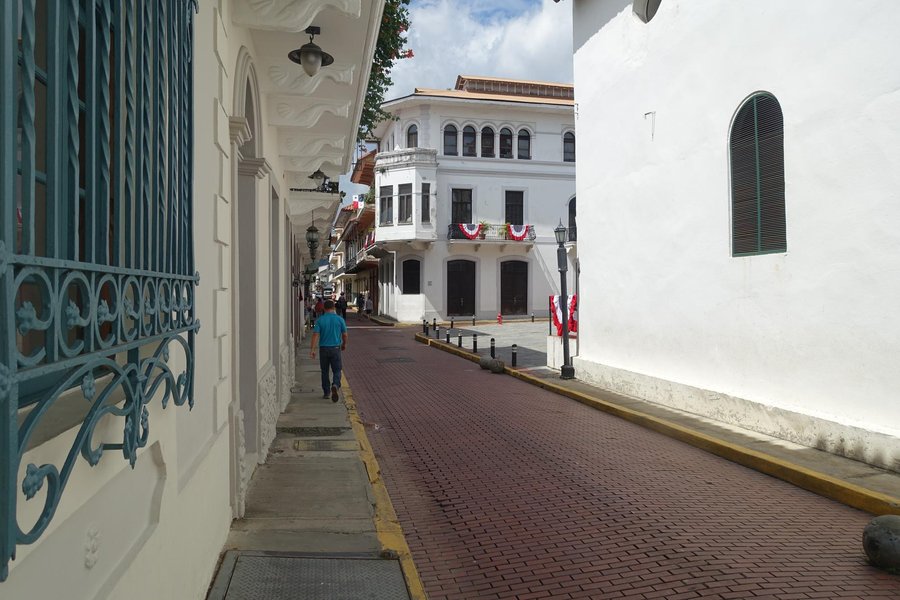
Updated 14 July 2025.
Panamá went for something creative. They delisted Panamá and replaced it with the route. Of which Panamá became a member. So my original complaint re redundant WHS is not applicable. Still, Panamá was a perfectly fine WHS by its own merits. I would really need to see evidence that the route makes this a richer experience than the prior configuration. Looking forward to reviews. As an aside, replacing WHS was quite a hassle on the IT side of things.
Original.
Panama has managed the rather remarkable feat to show how weak their nomination is in the very first sentence of their nomination:
"It is a serial property which comprises 5 component parts, several of which already have been inscribed on the World Heritage list[.]"
Executive summary: Of the 5 proposed components 3 are already inscribed as Panama and Portobelo and San+Lorenzo. This leaves the two roads connecting the Caribbean and Pacific coast as sole new addition.
I effectively ticked this off on my short visit to Panama by visiting Panama and Portobelo. I even made an effort in Panama to follow the road a little bit in downtown.
OUV
I really don't think serial combinations consisting primarily of already inscribed sites should be given any consideration. This does not belong on the list and is well covered by the already inscribed sites.
Getting There
Visiting Panama already gets you there, so there is little to add here.
Keep reading 0 commentsAnonymous
The Colonial Transisthmian Route of Panamá
The Colonial Transisthmian Route of Panamá (Inscribed)
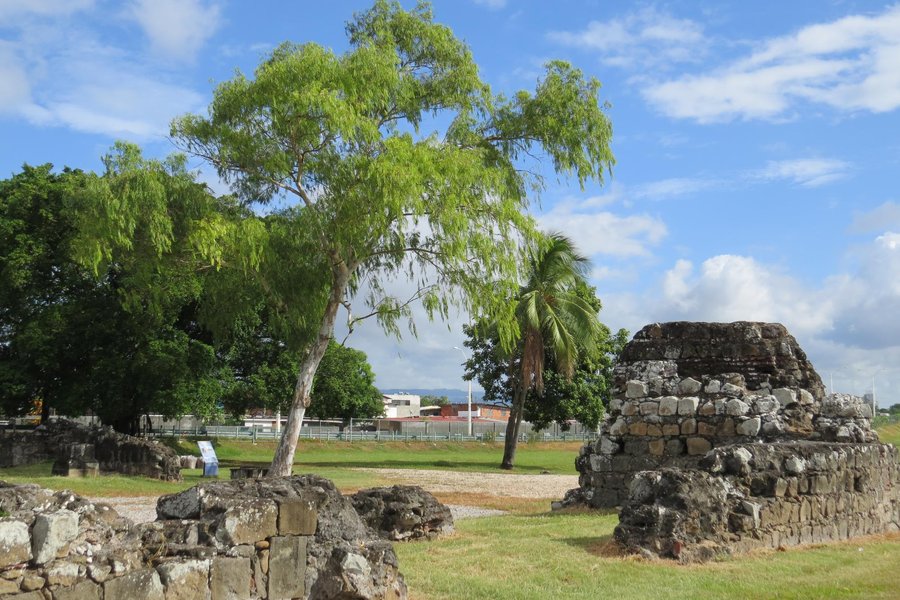
I'm living just across the street from Old Panama WHS, since I moved here 8 months ago I decided to take care of the area as a conscience citizen. Since the Patronato took care of the whole area, you can notice the work they have done, but also the work that must be done to make these WHS a more inclusive and better protected site at the same time. If you look closely, the Panamanians are not allow to enter the premises, leaving the green space between the entrance and the main structures (1000 * 50 mts), full of unused urban space for a ever growing population. In the other hand the lower part of the site is been affected by the rising sea level, increasing it vulnerability for climate change. A new road passing by the WHS, it had increased the traffic, as the vibration at the west entrance of the site, affecting notable to an old structure. Work need to be done, in order to mitigate climate change impacts, develop a green urban area for all the people to enjoy and reduce the vibration on some old structure must be part of the work to upgrade and protect this important WHS.
Keep reading 0 comments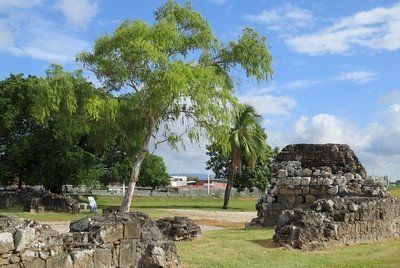
This Panamá City WHS covers two locations along the Pacific Coast: the site of the oldest European town on the American mainland and the first European settlement on the Pacific Coast of the Americas. It was inscribed in two stages, with reasons for inscription varying from inter-oceanic communications to Panamanian house types, and from 16th/17th-century town planning and architecture to Simon Bolivar's visionary attempt in 1826 to establish a multinational congress in the Americas. Whenever I see so many different arguments put forward, I always suspect real Outstanding Universal Value is lacking: such value surely would be much easier to pinpoint.
On my way to Nicaragua, I included a 3-day stop-over in Panamá and used it to explore this hard-to-grasp WHS and its Atlantic Ocean counterpart, Portobelo.
Panama Viejo lies in a relatively quiet area north of the city center. The Metrobus dropped me at the entrance, where I was asked to pay the foreigner's fee of 8 US dollars. This ticket includes both the museum and the archaeological site. The museum only covers one floor but presents the story of this site well. This was the first spot where the Spaniards settled on the Pacific Coast. It was clear from the start that the location wasn't great: a lack of drinking water and a healthy environment sent them looking for an alternative from 1531 on.
The remains of this old settlement are spread out on a narrow stretch of land along the Pacific coast. I enjoyed walking here, I …
Keep reading 0 commentsEsteban Cervantes Jiménez
The Colonial Transisthmian Route of Panamá
The Colonial Transisthmian Route of Panamá (Inscribed)
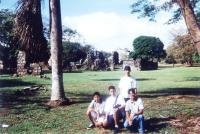
I visited both Panama Viejo and Casco Viejo in january 1999, as part of a prize for winning the 3rd spot in Costa Rica's National Scientific Fair, together with 3 members of our group. We visited also sites outside the WH site, as Cerro Ancón, the Esclusas Miraflores, the aquarium, the canopy observatory "National Park" (from where one can see the best views of the city) and the Smithsonian's Barro Colorado island. And although my peers were most interested in the shopping malls (many Costa ricans go to Panama just to shop, as it is duty free area), I managed to make them come along with me on a taxi ride to the ruins of Panama Viejo.
The most important thing about this component of the site is probably the history it guards, as it sometime, before its destruction, was one of the richest cities in the world, by managing the gold and silver of Peru and Potosí. Its ruins (the old Cathedral stands out among them) are not impressive, but still communicate you a sense of days forgone. About the security...our cab driver warned us that this site had a very poor security record, and had some disbelief that we planned to visit the site, but my enthusiasm worked to convince everyone. Nothing happened, except seeing some homeless people, and I understand that the site was renewed and the conditions have improved since.
Then we headed by cab to Panama Viejo and we had a short taste of some …
Keep reading 0 commentsClyde
The Colonial Transisthmian Route of Panamá
The Colonial Transisthmian Route of Panamá (Inscribed)
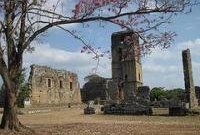
I visited this WHS in January 2011. Panama Viejo is quite a let down, all that is left is a bunch of ruins. However, Casco Viejo, the historic district of Panama City is really worth a visit. The view from Cerro Ancon is breathtaking as is the view from a closed down dancing place in the historic district where you can enjoy an unobstructed view of the modern Panama City skyline.
Keep reading 0 commentsSolivagant
The Colonial Transisthmian Route of Panamá
The Colonial Transisthmian Route of Panamá (Inscribed)
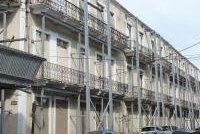
On our previous visit to Panama way back in 1991 neither the ruined Panama Viejo nor the Casco Viejo historic district of Panama City had yet been inscribed. Nevertheless we paid reasonable attention to the former because of its obvious historic interest but the latter seemed to pass us by without us having fully appreciated its possible merits! It had seemed just another colonial centre among many in Latin America and, after a quick perusal, we had moved on to the Canal and to Portobelo in our rentacar! So, in 2012, when we did a transit of the Canal by ship and then had a day at the Balboa end we determined to try to fill in on what we might have missed!
Casco Viejo is set well apart from modern bustling Panama City on a small peninsula surrounded by some of the less salubrious parts of the city. I am not normally one to worry overmuch about “safety warnings” in cities (though I have, possibly as a result, have been mugged twice in my travelling career!) but the district of El Chorillo just to the west of the Casco has a particularly tough reputation as does that of nearby Santa Ana . The former was Noriega’s boyhood neighbourhood, the location of his HQ, the heartland of his populist support and the location of much of the bombing during the US invasion. Our taxi driver emphasized the “peligroso” of the area and had us lock our doors as we passed …
Keep reading 0 commentsPhilip T.K.
The Colonial Transisthmian Route of Panamá
The Colonial Transisthmian Route of Panamá (Inscribed)
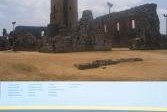
It takes around two hours to reach Casco Viejo, the historical district of Panama, from Portobelo (another WHS). Quick glimpses of the famous Panama Canal can be seen on the way. In Casco Viejo, the cathedral and the ruins of numerous churches are worth a quick visit. Most of the interesting sites are located near each other so walking is the best option. The president of Panama also lives here so a heavy police presence can be sensed.
After a brief visit, we headed towards Panama Viejo across town. This site was added to the WHS in 2003 as an extension. Although mostly ruined, I found this archaeological site to be the highlight of my visit to Panama. Unlike most colonial sites, I saw very little reconstruction in this one which gave it a sense of authenticity.
I should mention, however, that Panama Viejo is not for everyone. My parents and brother were very unimpressed with the crumbling state of the buildings and decided to sit out after a cursory visit. Most tour groups I saw only visited the museum, which contains many impressive artifacts, and the cathedral site. I would recommend walking the trail from the museum to the cathedral site if time permits. Ruins of various churches line it. The climb to the top of the cathedral is also worthwhile and great views of the city skyline can be seen.
Overall, I thoroughly enjoyed my visit to this WHS. Although overshadowed by the famous canal, I was very …
Keep reading 0 comments
